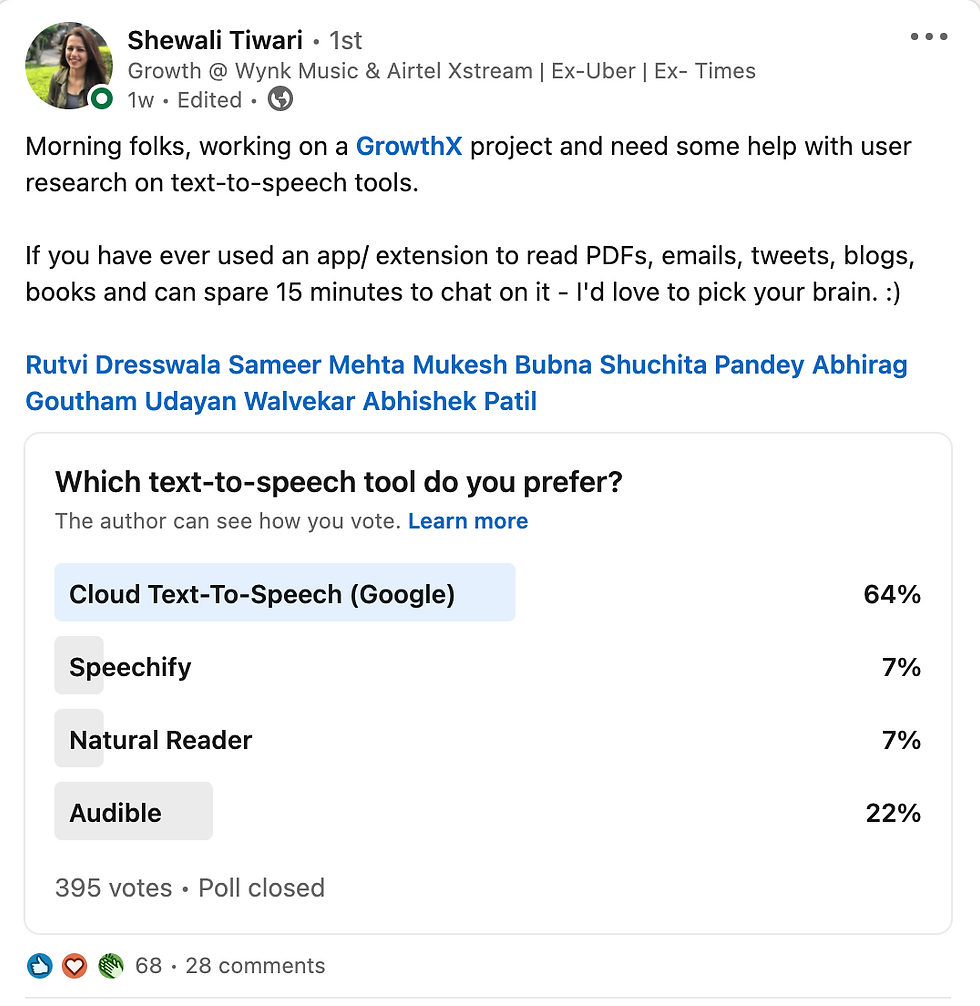S01E07 - The Art of User Research
- Jun 22, 2021
- 4 min read
Have you ever Googled something and then gone down a rabbit hole?
For instance, if a doctor asked me to get a blood test done, my next step is to open WebMD. By the end of the day, I have probably landed on the conclusion that I have cancer.
Or, if I am researching about a product, I keep reading articles after articles, jumping from one link to another. At the end of this tunnel, the time invested doesn't give one an equivalent return.
You see, running sprints around articles on Google as research isn't enough. In fact, you might likely get overwhelmed with the amount of information available. You need to plan, structure, and document your work, throughout the process.
In this episode of the Startup Life, I am covering what helped me and my GrowthX capstone team while conducting user research on our product, 'Speechify'.
Let's get started!
Step 1 - Plan
The first step is the most crucial one. You have to spend time to understand:
What does this product aim to achieve?
What is the feasibility of this product?
Does this product have a market?
Who are its competitors in this market and, what do they do? ..etc
Your knowledge about the product and the market will become the cornerstone of your research
Step 2 - Hypothesis
Based on your research you will create your hypotheses asking:
Who is your user?
What is their problem statement and, how are they solving it currently?
Will your product help them?
How will they use your product?
Would they be willing to spend money on your product? If yes, then how much? ..and more
Once you have your basic hypothesis ready, it's just a matter of validating it.
Step 3 - Hunt
Now you have a brief understanding of your product and customers. The next step is to hunt for the right customers.
Where can you find your customers and their respective feedback?
Social Media Platforms like Twitter, Instagram, Linkedin, Reddit, etc have people from all walks of life and you will most likely find someone who fits your criteria. Based on your product, some platforms would be more effective than others. For instance, you are unlikely to find users of Hubspot (a B2B product) on Instagram, but you would have better luck on Linkedin.
Product reviews/feedback If your product is already in the market then look at reviews from your product and your competitors', to understand their needs. If you are building for a new problem statement, then find the gaps in the current solution.
Community forums There are a ton of online forums where people ask questions. Based on your use case, find the appropriate forum to identify your customers' problems and what kind of solutions they find online. A good place to start is forums like Quora and Reddit.
Your network More times than not, if you have a decent network, you will have a sample set of your ideal customer within your network. Reach out to these people, tell them what you are trying to do, and find someone accordingly.
Step 4 - Approach
You are halfway there. You have your product, the questions, and knowledge of who to approach. So how do you get information out of these people?
There are a few methods. These are my top three:
Polls If you have a question that is simple in nature, run polls that are targeted to your user groups. You can run polls on various open platforms such as LinkedIn, Instagram, Reddit, etc. If you have a focus group then there are a lot of polling tools available online to help you out. Here is an example of what we did for our project:

Surveys You can never go wrong with short and quirky surveys that keep the users engaged till the last question. Check out this beginner's guide to surveys to understand how to run user research surveys.
User Calling This is my personal favorite and the most effective way of doing user research. Nothing can beat the quality of information that you would get from a 1-on-1 session with a customer. However, approaching customers for feedback/research calls is tricky and more times than not, people refuse to have a conversation. It is easier to approach people within your network for new products, and existing customers for launched products.
Step 5 - Articulate
People value time and they don't value anyone who wastes theirs. So you must articulate your thoughts and questions when you approach users.
Be crisp and to the point when you are creating polls/surveys, talking to customers, or approaching users in any way.
Step 6 - Document
This is the most underrated and neglected part while doing research. Documenting will give structure to your research and will help bring everything together in the end.
Make it a habit to document everything from the research articles you read to your approach while reaching out to customers to the feedback you received.
You have mastered the art! (More like scratched the surface, but it's okay)
I do not claim to be an expert on user research, but these simple steps worked out for an immature and early PM like myself. I hope it helps you get started with your project.
Thanks for reading! :)
If you enjoyed the article, hit that ❤️ button.
If you loved the article, SUBSCRIBE.

Hey! I am Rutvi.
Thanks for checking out The Startup Life.
It’s my escape from the daily rut and I hope to become a better version of myself through writing.
I do product management as my day gig and writing by the night. Also, a Mumbai girl and marine drive is ♥️



Comments